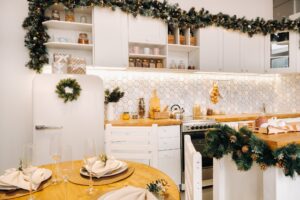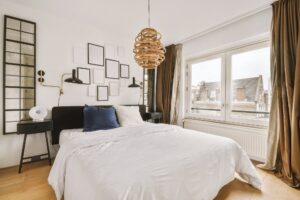As people become more conscious of how their decisions affect the environment, sustainable and eco-friendly design has grown in popularity. Using recycled or upcycled materials, energy-efficient fixtures and appliances, and renewable energy sources are just a few examples of the ecologically friendly materials and methods that are the focus of this design philosophy. Sustainable design not only considers the environment but also frequently enhances indoor air quality & uses non-toxic materials to create healthier living spaces. Minimizing waste & resource usage is one of the main tenets of sustainable design. This can be accomplished by carefully planning & designing the space, such as by putting in low-flow plumbing fixtures to save water, utilizing natural lighting to lessen the need for artificial lighting, or repurposing wood for furniture or flooring.
Key Takeaways
- Sustainable and eco-friendly design focuses on using environmentally friendly materials and energy-efficient practices in building and interior design.
- Biophilic design incorporates natural elements and patterns to create a connection to nature and improve well-being in indoor spaces.
- Multifunctional and flexible spaces are designed to adapt to different needs and activities, maximizing the use of space and promoting versatility.
- Bold and vibrant color palettes add energy and personality to a space, creating a lively and dynamic atmosphere.
- Vintage and retro revival brings back nostalgic elements from the past, adding character and charm to modern interiors.
- Statement lighting and unique fixtures serve as focal points and add visual interest to a space, enhancing its overall design.
- Minimalist and Scandinavian influences emphasize simplicity, functionality, and clean lines in interior design, promoting a sense of calm and order.
Energy efficiency is a key component of sustainable design and can be attained by using energy-efficient appliances, adequate insulation, and passive heating and cooling techniques. Through the integration of these principles into their designs, architects and interior designers can produce visually stunning spaces that simultaneously benefit the environment and their occupants. Sustainable design represents a fundamental paradigm shift in the fields of architecture & interior design, not merely a passing fad. Designers can create visually appealing spaces that also contribute to a healthier planet for future generations by prioritizing the use of sustainable materials and practices. We should anticipate seeing an even bigger focus on eco-friendly design in the years to come as more people realize how important sustainability is. The idea of “biophilic design” aims to create a built environment that fosters human connection with nature.
By incorporating natural elements like plants, natural light, & organic materials into interior spaces, this approach acknowledges the innate human need to be in touch with nature. The goal of biophilic design is to create spaces that enhance productivity, lessen stress, and foster well-being by bringing the outdoors inside. Using organic materials like wood & stone, as well as constructing indoor gardens or living walls, are just a few ways to incorporate nature-inspired elements into interior design.
Owing to its demonstrated benefits for mood & productivity, natural light is also a crucial element of biophilic design. A sense of connection to the outdoors can also be fostered by including views of nature, such as those seen through large windows or well-placed artwork. Instead of being a fad, biophilic design represents a fundamental change in how we think about interior spaces. We can design spaces that are not only aesthetically pleasing but also beneficial to our health by giving the relationship to nature first priority. With our lives becoming more and more urbanized and cut off from the natural world, biophilic design provides a means of integrating the advantages of the natural world into our daily environments.
Flexible and multipurpose spaces are becoming more and more necessary in today’s fast-paced world. Designers are coming up with inventive ways to maximize interior space functionality, whether it’s because of the restricted square footage in urban areas or the need for flexible living and working environments. This strategy entails creating rooms that have several uses, like a living room that is easily convertible into a dining area or a home office that doubles as a guest bedroom. The use of modular furniture and storage solutions that are simple to reconfigure to suit changing needs is one method to create multipurpose & flexible spaces. In a small apartment, space can be maximized with pieces like a coffee table that can be raised to dining table height or a sofa with built-in storage.
Moveable partitions and open floor plans can also produce adaptable spaces that can be adjusted to various activities or take into account shifting family dynamics. As individuals look for ways to maximize their living and working environments, there will probably always be a need for multipurpose & adaptable spaces. By using this method in their work, architects and interior designers are able to produce spaces that are not only useful & efficient, but also flexible enough to change with the needs of the people using them. Vibrant and bold color schemes are returning to interior design, giving rooms character & vitality.
Bold colors are currently in because they can create a sense of drama & make a statement, while neutral colors have long been favored for their adaptability & timeless beauty. Bold color schemes, which range from vivid primary hues to rich jewel tones, can give any space depth and personality. Using vibrant furniture or accessories as focal points or painting an accent wall in a striking hue are just two ways to incorporate bold colors into interior design. In an open floor plan, bold colors can also be used to define distinct areas & add visual interest. Plus, a room can feel playful & eclectic when bold colors are mixed and matched.
Even though they might not be for everyone, bold colors in interior design provide a platform for individuality and creativity. Bold color schemes allow designers to create vivid, individual spaces that infuse daily environments with excitement and vitality. As more people look to infuse their spaces with nostalgia & character, the vintage and retro revival in interior design is growing in popularity. The idea behind this trend is to add vintage-inspired patterns, art deco accents, and mid-century modern furniture to modern interiors. Designers are able to make spaces that feel timeless and distinctive by combining modern and traditional elements.
The sense of history and narrative that these elements impart to a space is one of the main draws of vintage and retro revival. Retro-inspired wallpaper patterns or old-fashioned rugs with rich patinas can infuse a space with character & depth. Also, many modern furnishings lack the durability and quality of craftsmanship found in vintage pieces. Vintage and retro revival offer a way to add character and charm to interior design as people look to create environments that feel more genuine and personal.
Designers can make rooms that feel both new and familiar by combining elements from earlier eras, which brings comfort & nostalgia to today’s hectic world. With their ability to add drama and individuality to spaces, statement lighting & distinctive fixtures are becoming an increasingly important component of interior design. A room’s focal points can double as functional lighting fixtures, whether it’s a sculpture-like chandelier, an enormous pendant light, or an artistic sconce. Designers can produce atmosphere and visual interest in any space by selecting lighting that makes a statement.
Statement lighting can highlight architectural features or help define distinct areas within an open floor plan, in addition to acting as decorative elements. In the living room or bedroom, wall sconces can provide coziness and warmth, while a striking pendant light can highlight the kitchen island or dining area. Also, distinctive fixtures can be independent pieces of art that infuse a room with originality and skill. Statement lighting provides an opportunity for self-expression and creativity in interior design as individuals look for ways to make their living spaces uniquely their own.
Everyday living spaces can be given personality & character by designers through the use of fixtures that make a statement, making them feel special and unforgettable. The emphasis on comfort, functionality, and simplicity in minimalist and Scandinavian design continues to make them popular choices for interior spaces. Simple shapes, open layouts, and organic materials are given priority in these design strategies to produce serene, welcoming spaces. Designers are able to create timeless and functional spaces by embracing Scandinavian design principles & minimalism. Neutral color palettes, like white, gray, and earth tones, are essential to minimalist and Scandinavian design because they foster a sense of harmony and tranquility in a room.
In order to create light & airy interiors, these design strategies also frequently emphasize natural light and straightforward yet practical furniture. Spaces that are minimalist & Scandinavian-inspired radiate serenity and mindfulness because they prioritize quality above quantity. Thoughtful design with minimalist and Scandinavian influences can help people simplify their lives and create peaceful living spaces. Architects and interior designers may create environments that feel timeless and harmonious while also enhancing user well-being by incorporating these ideas into their designs.
If you’re interested in staying up to date with the latest interior design trends, you may also want to check out this article on how to decorate your living room on a budget. It offers practical tips and ideas for creating a stylish and inviting living space without breaking the bank.
FAQs
What are the top interior design trends this year?
The top interior design trends this year include sustainable and eco-friendly materials, maximalist decor, vintage and retro furniture, and biophilic design elements.
What are sustainable and eco-friendly materials in interior design?
Sustainable and eco-friendly materials in interior design include reclaimed wood, bamboo, cork, recycled glass, and natural fibers such as jute and hemp. These materials are chosen for their minimal environmental impact and renewable properties.
What is maximalist decor in interior design?
Maximalist decor in interior design is characterized by bold patterns, vibrant colors, and an eclectic mix of furniture and accessories. It embraces the idea of “more is more” and encourages layering and mixing different styles and textures.
What is biophilic design in interior design?
Biophilic design in interior design is the incorporation of natural elements such as plants, natural light, and organic materials into the built environment. It aims to create spaces that connect people with nature and promote health and well-being.
How can I incorporate vintage and retro furniture into my interior design?
You can incorporate vintage and retro furniture into your interior design by mixing it with modern pieces, using it as a focal point in a room, or repurposing it for a new function. Vintage and retro furniture adds character and a sense of history to a space.





